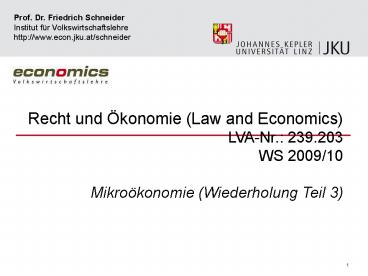Die Johannes Kepler Universitt Linz
1 / 15
Title:
Die Johannes Kepler Universitt Linz
Description:
Mikro konomie (Wiederholung Teil 3) 1. Prof. Dr. Friedrich Schneider ... Recht und konomie WS09/10 Mikro konomie Wiederholung Teil 3 Prof. Dr. Friedrich Schneider ... – PowerPoint PPT presentation
Number of Views:22
Avg rating:3.0/5.0
Title: Die Johannes Kepler Universitt Linz
1
Prof. Dr. Friedrich Schneider Institut für
Volkswirtschaftslehre http//www.econ.jku.at/sch
neider
Recht und Ökonomie (Law and Economics) LVA-Nr.
239.203 WS 2009/10 Mikroökonomie (Wiederholung
Teil 3)
1
2
Outline of the section on Microeconomics
- 1 Basic concepts and tools
- Consumer theory
- Theory of the firm
- 4 Interactions of households and firms
- 5 Game theory
- 6 Pricing of assets
- 7 Welfare economics
- 8 Uncertainty
3
5.1 Game Theory
- Basic objective general analysis of strategic
interaction(s) - Applications
- war or arms race
- political negotiations
- markets economics of imperfect competition
- legal disputes
- competitions, e. g. sports
4
5.2 Payoff Matrix of a Game
- Outcome of a game (gains or losses) for any given
pair of action/reaction by players involved - Dominant strategy
- A bottom
- B left
5
5.3 Nash-Equilibrium
- Each players choice is optimal given the other
players choice - Nash-Equilibrium
- if A chooses top, B will choose left
- If B chooses left, A will choose top
- thus (top, left) is a Nash-Equilibrium
- but (bottom, right) is also a Nash- Equilibrium!
6
5.4 Prisoners Dilemma
- Bonny Clyde are suspected of a robbery
questioned in separate rooms. - There is no conclusive evidence, thus
- confession is needed for a conviction for
robbery otherwise its only illegal possession
of a weapon. - No one confesses 1 year for both.
- One confessor goes free, the other will get 6
years. - Both confess, each gets 3 years.
7
5.5 Payoff Matrix for the Prisoners Dilemma
- Unique Nash- equilibrium is for both to confess.
- Obviously it would be optimal for both to deny
Pareto optimum! - Applications
- cartel cheating
- arms control
8
5.6 One-shot vs. Repeated Games
- Which is the correct way to play the game?
- Important finite or infinite number of rounds!
- with finite number of rounds no change in the
outcome - with infinite repetitions of the game if
cooperation is best (Pareto-optimal) threat of
non-cooperation may (will?) induce cooperation. - Experiment use experts favourite strategies of
P. D. in a computer simulation - outcome simple tit-for-tat gets highest payoff!
9
5.7 Sequential Games
- Thus far players acted simultaneously.
- Now suppose that one player (A) starts.
- He will choose bottom
- outcome (bottom, right)
- But B would prefer top!
- B could threaten A to choose left credibility?
- Monopolist (B) deters entry of competitor (A).
10
5.8 Pure and Mixed Strategies
- Pure strategy choice is made and then maintained
(with certainty). - Mixed strategy the choice by each player has a
certain probability. - Sometimes there may be no equilibrium solution in
pure, but only in mixed strategies.
11
5.9 Applications of Game Theory (1)
- Games of coordination
- prisoners dilemma contract
- arms race disarmament agreement
- Games of competition
- assumption on probable reaction of competitor
- Games of coexistence
- biology (dove-hawk game)
12
5.10 Applications of Game Theory (2)
- Games of commitment
- frog/scorpion
- kidnapper/hostage
- generations
- Bargaining games
- Nash bargaining specify properties of
reasonable solution and show uniqueness of
solution. - Rubinstein bargaining analyse sequence of
choices and solve for subgame perfect
equilibrium (e.g. division of a given sum only
fair offer will be acceptable social norm of
behaviour?).
13
6.1 Pricing of Assets
- An asset can be land, a company, shares in a
corporation, a patent, an annuity, - The asset generates income, assumed to accrue
annually rent, dividend, interest, ... - In principle, the value of an asset is the sum of
the income stream, F, it generates over its life
span, n. - Due to time preferences, income accruing in the
future has to be discounted at the rate r.
14
6.2 Present discounted value
- We assume an income stream over a fixed period of
time, n. - Then the present discounted value (PDV) becomes
- PDV F1/(1r) F2/(1r)2 F3/(1r)3
Fn/(1r)n - For an infinite constant income stream, F, we get
- PDV F/r
15
6.3 Applications of Asset Pricing
- Determine value of damages, e. g. of destroyed
property - Value of land in case of expropriation
- Value of life































